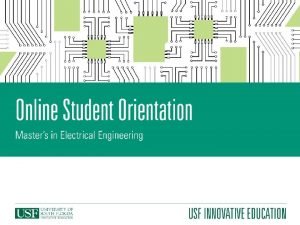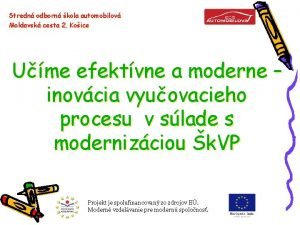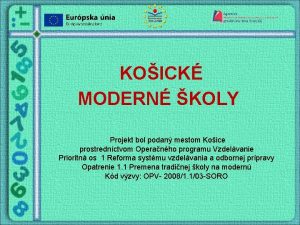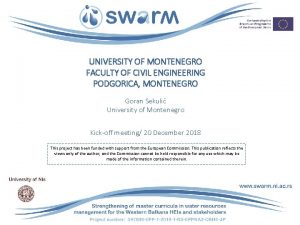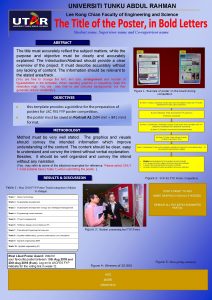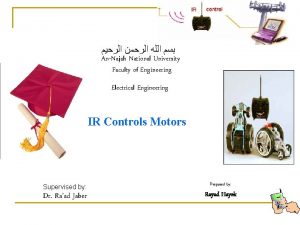Technical University of Koice Faculty of Electrical Engineering









































- Slides: 41

Technical University of Košice Faculty of Electrical Engineering and Informatics Department of Electrical Power Engineering Advanced Teaching Techniques Establishing Smart Energy System Curriculum at Russian and Vietnamese Universities Training on Advanced Teaching Techniques for Smart Energy System Study Program Riga, Latvia, 20 th March 2019

Brainstorming • • • Introduction What is Brainstorming? Why use Brainstorming? Individual Brainstorming Group Brainstorming How to use the Brainstorming (Step 1: Prepare the group; Step 2: Present the problem; Step 3: Guide the discussion) Further steps of Brainstorming The next step – Taking action 7 techniques for effective brainstorming Creative thinking with brainstorming How often have you use brainstorming to solve a problem?

Introduction Brainstorming is a group creativity technique by which efforts are made to find a conclusion for a specific problem by gathering a list of ideas spontaneously contributed by its members. Brainstorming is a situation where a group of people meet to generate new ideas and solutions around a specific domain of interest by removing inhibitions. People are able to think more freely and they suggest many spontaneous new ideas as possible. All the ideas are noted down and those ideas are not criticized and after brainstorming session the ideas are evaluated. For decades, people have used brainstorming to generate ideas, and to come up with creative solutions to problems. However, you need to use brainstorming correctly for it to be fully effective.

What Is Brainstorming? Brainstorming combines a relaxed, informal approach to problem solving with lateral thinking. It encourages people to come up with thoughts and ideas that can, at first, seem a bit crazy. Some of these ideas can be crafted into original, creative solutions to a problem, while others can spark even more ideas. This helps to get people unstuck by ‘jolting’ them out of their normal ways of thinking. Therefore, during brainstorming sessions, people should avoid criticizing or rewarding ideas. You're trying to open up possibilities and break down incorrect assumptions about the problem's limits. Judgment and analysis at this stage stunts idea generation and limit creativity. Evaluate ideas at the end of the session – this is the time to explore solutions further, using conventional approaches.

Why Use Brainstorming? Conventional group problem solving can often be undermined by unhelpful group behavior. And while it is important to start with a structured, analytical process when solving problems, this can lead a group to develop limited and unimaginative ideas. By contrast, brainstorming provides a free and open environment that encourages everyone to participate. Curious ideas are welcomed and built upon, and all participants are encouraged to contribute fully, helping them develop a rich array of creative solutions.

Why Use Brainstorming? When used during problem solving, brainstorming brings team members' diverse experience into play. It increases the richness of ideas explored, which means that you can often find better solutions to the problems that you face. It can also help you get buy-in from team members for the solution chosen – after all, they are likely to be more committed to an approach if they were involved in developing it. What is more, because brainstorming is fun, it helps team members bond, as they solve problems in a positive, rewarding environment. While brainstorming can be effective, it is important to approach it with an open mind a spirit of non-judgment. If you don't do this, students ‘clam up’, the number and quality of ideas plummets, and morale can suffer.

Individual Brainstorming While group brainstorming is often more effective at generating ideas than normal group problem solving, several studies have shown that individual brainstorming produces more – and often better – ideas than group brainstorming. This can occur because groups are not always strict in following the rules of brainstorming, and bad behaviors creep in. Mostly, though, this happens because people pay so much attention to other people that they do not generate ideas of their own – or they forget these ideas while they wait for their turn to speak. This is called blocking.

Individual Brainstorming When you brainstorm on your own, you do not have to worry about other student's egos or opinions, and you can be freer and more creative. For example, you might find that an idea you had hesitate to bring up in a group develops into something special when you explore it on your own. However, you may not develop ideas as fully when you are on your own, because you do not have the wider experience of other group members to draw on.

Individual Brainstorming When you brainstorm on your own, you do not have to worry about other student's egos or opinions, and you can be freer and more creative. For example, you might find that an idea you had hesitate to bring up in a group develops into something special when you explore it on your own. However, you may not develop ideas as fully when you are on your own, because you do not have the wider experience of other group members to draw on. Individual brainstorming is most effective when you need to solve a simple problem, generate a list of ideas, or focus on a broad issue. Group brainstorming is often more effective for solving complex problems.

Group Brainstorming Here, you can take advantage of the full experience and creativity of all team members (students). When one member gets stuck with an idea, another member's creativity and experience can take the idea to the next stage. You can develop ideas in greater depth with group brainstorming than you can with individual brainstorming. Another advantage of group brainstorming is that it helps everyone feel that they have contributed to the solution, and it reminds people that others have creative ideas to offer. It is also fun, so it can be great for team building!

Group Brainstorming Group brainstorming can be risky for individuals. Unusual suggestions may appear to lack value at first sight – this is where you need to chair sessions tightly, so that the group does not crush these ideas and stifle creativity. Where possible, participants should come from a wide range of disciplines or study fields. This cross-section of experience can make the session more creative. However, do not make the group too big: as with other types of teamwork, groups of five to seven people are usually most effective.

How to Use the Brainstorming You often get the best results by combining individual and group brainstorming, and by managing the process according to the ‘rules’. By doing this, you can get students to focus on the issue without interruption, you maximize the number of ideas that you can generate, and you get that great feeling of team bonding that comes with a well-run brainstorming session! To run a group brainstorming session effectively, follow these next steps.

Step 1: Prepare the Group First, set up a comfortable meeting environment for the session. Make sure that the room is well-lit and that you have the tools, resources, and refreshments that you need. How much information or preparation does your team need in order to brainstorm solutions to your problem? Remember that preparation is important, but too much can limit – or even destroy – the freewheeling nature of a brainstorming session. Consider who will attend the meeting. A room full of likeminded people won't generate as many creative ideas as a diverse group, so try to include students from a wide range of study programs, and include people who have a variety of different thinking styles.

Step 1: Prepare the Group When everyone is gathered, appoint one person to record the ideas that come from the session. This person should not necessarily be the team manager – it is hard to record and contribute at the same time. Post notes where everyone can see them, such as on flip charts or whiteboards; or use a computer with a data projector. If students are not used to working together (i. e. from different study programs), consider using an appropriate warm-up exercise, or an icebreaker.

Step 2: Present the Problem Clearly define the problem that you want to solve, and lay out any criteria that you must meet. Make it clear that the meeting's objective is to generate as many ideas as possible. Give students plenty of quiet time at the start of the session to write down as many of their own ideas as they can. Then, ask them to share their ideas, while giving everyone a fair opportunity to contribute.

Step 3: Guide the Discussion Once everyone has shared their ideas, start a group discussion to develop other students' ideas, and use them to create new ideas. Building on others' ideas is one of the most valuable aspects of group brainstorming. Encourage everyone to contribute and to develop ideas, including the quietest people, and discourage anyone from criticizing ideas. As the group facilitator, you should share ideas if you have them, but spend your time and energy supporting your team and guiding the discussion. Stick to one conversation at a time, and refocus the group if people become sidetracked.

Step 3: Guide the Discussion Although you are guiding the discussion, remember to let everyone have fun while brainstorming. Welcome creativity, and encourage your team to come up with as many ideas as possible, regardless of whether they are practical or impractical. Use thought experiments such as Provocation or Random Input to generate some unexpected ideas. Do not follow one train of thought for too long. Make sure that you generate a good number of different ideas, and explore individual ideas in detail. If a team member (student) needs to ‘tune out’ to explore an idea alone, allow them the freedom to do this. Also, if the brainstorming session is lengthy, take plenty of breaks so that students can continue to concentrate.

Further Steps of Your Brainstorming If you are not getting enough good quality ideas, try using the approaches below to increase the number of ideas that you generate: • The Stepladder Technique – This improves the contribution of quieter group members by introducing one person at a time. • Brainwriting – This is a written approach that you can use to encourage all individuals to generate and develop ideas. • Online Brainstorming (also known as Brain-netting) – An electronic method of brainstorming, this uses a document stored on a central server, or on a Cloud-based system. • Crawford's Slip Writing Approach – You can use this approach to get plenty of ideas from all participants, and to get a view of each idea's popularity.

• • • These techniques help you in specific situations: Reverse Brainstorming – This is used to improve a product or service. Starbursting – Starbursting helps you develop questions that you need to ask to evaluate a proposal. Charette Procedure – This helps you brainstorm with large groups of students. (Conventional brainstorming becomes increasingly ineffective when more than 10 or 12 people are involved. ) Round-Robin Brainstorming – You can use this approach to get students to contribute ideas without being influenced by others. Rolestorming – This technique encourages group members to take on other students' identities while brainstorming, thereby reducing their inhibitions.

The Next Step – Taking Action After your individual or group brainstorming session, you'll have a lot of ideas. Although it might seem hard to sort through these ideas to find the best ones, analyzing these ideas is an important next step, and you can use several tools to do this. Use Affinity Diagrams to organize ideas and find common themes. Decision Matrix Analysis and Paired Comparison Analysis will help you choose between different options. You can also use the Six Thinking Hats technique to look at ideas from different perspectives; and the Modified Borda Count and Multi-Voting can help you choose between options as a team, particularly where the differences between options are quite subjective.

7 Techniques for More Effective Brainstorming Does brainstorming ever feel like a total waste of time? You believe it is necessary to get your team's input on a topic, but the session usually just turns into a few students bickering, and the other participants saying nothing at all. Even if it was a good session (lesson) with solid ideas, the meeting notes (if there any) will most likely end up lost in an email chain abyss never to be found again. These are classic examples of brainstorming gone wrong. When venturing into the world of brainstorming, keep a few important things in mind. Do not get lazy when you brainstorm – keep it both efficient and effective. Now, I will introduce you seven easy brainstorming techniques that encourage collaboration while eliminating judgment.

1. Brain Writing The general principle of this technique is to separate idea generation from discussion. The team leader shares the topic with the students, and students individually write down their ideas. This helps eliminate the anchoring bias and encourages everyone on the team to share their own ideas. It also gives everyone more time to think over their ideas, which is especially helpful for your introverted participants. This brainstorming technique works best for teams who seem to be greatly influenced by the first ideas presented during a meeting. When your team is brainstorming ideas individually, away from distraction and public opinion, you generate concepts that may not naturally surface in a larger setting. Individual brainstorming techniques like this will often give you more unique ideas than when the group comes up with topic ideas together.

2. Figuring Storming Ever consider how someone else might handle the situation? Or what they might say about a particular topic? With figuring storming, you aim to do just that. Think about how someone like your teacher, a famous celebrity, or even the president of the United States might handle the situation. Putting yourself in new shoes can give the team a different perspective, helping them see the possibilities from fresh ideas. This technique works best for teams who find themselves coming across the same ideas for repetitive projects. Try the simple question: What would president do? When you brainstorm questions that revolve around the possible actions of a third party, you free up ideas that are not limited to your students. It is one of those exercises for teams that gives everyone a different viewpoint.

3. Online Brainstorming (Brain-netting) Virtual teams are becoming more and more common across all industries. The evolution of email and collaboration tools make working remotely the norm in some organizations. But what happens when the team needs to come together to brainstorm? Sure, ideas can be tossed back and forth through email, but then it becomes difficult to archive those ideas for future reference. Creating a central location online where team members can collaborate is crucial for these virtual teams — consider cloud-based document storage or an online collaboration tool.

3. Online Brainstorming (Brain-netting) There also a ton of great brainstorming tools that help make online brainstorming more of a visual and collaborative experience. One brainstorming exercise for groups involves using an online mind-mapping tool to answer very specific questions or generate ideas tangential to the main problem. What other ideas surround this concept? Map these examples out, visually.

4. Rapid Ideation Sometimes, time limitations can help generate ideas quickly, because you do not have time to filter or overthink each one. With this technique, the team leader provides context beforehand with information or questions on the topic, budget, deadline, etc. Then, a time limit is set for individuals to write down as many thoughts or ideas around the topic as possible, using any mediums available. Participants should not worry about filtering their ideas.

4. Rapid Ideation The great part about this style of brainstorming is that it is completely customizable to meet the needs of the team and project. Several different mediums can be used, such as pen and paper, white boards, Post-Its. . . anything to get the creative juices flowing. The time limit for your rapid ideation session can be anywhere from five to 45 minutes, depending on the complexity of your topic. This technique is good for teams who tend to get sidetracked, teams who hate meetings, or for placing a time limit on brainstorming sessions that frequently last longer than expected.

4. Rapid Ideation Here is a tip you should take very seriously… get silly! Note: groups who shared funny or embarrassing stories about themselves came up with 26% more ideas in 15% more categories than the groups who did not. While brainstorming is the basic technique for developing ideas and getting people to think up new concepts and solutions, there is a very real temptation to overthink things. It is easy to get bogged down by every new idea and its details. This is precisely the problem that rapid ideation seeks to solve.

5. Round Robin Brainstorming Teams form a circle to kick off this method. Once the topic is shared, go around the circle one-by-one and have each student offer an idea until everyone has had a turn. Simultaneously, a facilitator records all ideas so they can be discussed once the sharing is over. It is very important to not evaluate any ideas until everyone has the opportunity to share. This technique is good when some of your students have a tendency to stay quiet throughout meetings. When leading a session, the round robin method of brainstorming allows everyone to pitch in and contribute. Just make sure to treat each idea with equal weight. And try to discourage students from saying "X already mentioned my idea. " If this does happen, say you will return to them at the end so they have time to think of something new.

6. Starbursting This form of brainstorming focuses on forming questions rather than answers. Starbursting challenges the team to come up with as many questions as they can about your topic. An easy way to begin a session like this would be to start listing questions that deal with the who, what, where, when, and why. This style assures that all aspects of the project are addressed before any work goes into executing it. It is a good technique for teams who tend to overlook certain aspects of a project and end up rushing to get things done last minute. Thinking up some good brainstorming questions has the added benefit of giving you an instant backlog of ideas for web content: In case you need a FAQ section for your website or product, simply answer the generated questions.

7. Stepladder Technique Developed in 1992, this style of brainstorming encourages every member in the team to contribute individually before being influenced by everyone else. The session begins with the facilitator sharing the topic or question with the whole team. Once the topic is shared, everyone leaves the room except two members of the team. These two members will then discuss the topic and their ideas. Then, one additional member is added to the group. This new member will contribute his or her ideas ‘before’ the other two discuss theirs. Repeat this cycle until everyone from the original group is in the room. This technique prevents groupthink in teams where one or two members hold sway over everyone else. This also helps encourage the shy folks in the group to share their ideas without feeling intimidated by a room full of people.

7. Stepladder Technique The stepladder technique is actually one of the more mature brainstorming strategies as it incorporates both an individual and a group participation aspect. This technique is useful for medium-sized groups of anywhere from five to 15 students. Once the group gets larger, however, it takes much longer and may become unwieldy.

The Benefits of a Group Brainstorm So why is brainstorming in a study group beneficial? The definition of brainstorming holds the key: It is a way to solve problems by holding a group discussion and collecting information or ideas that are arrived at via ‘unrestrained and spontaneous participation in discussion’. It is a useful method, especially in the early stages of a study or a university's growth, to bring together a wide range of viewpoints. Additionally, it is a quick way to generate a large quantity of ideas. Instead of just one or two, a group effort can exponentially increase the number of ideas.

The Benefits of a Group Brainstorm Here a few tips to help your next brainstorm become a resounding success: • Make the objectives crystal clear from the start. What are you trying to find/solve? What constraints are you operating under? • Just as with other collaborative meeting techniques, allow everyone to have a say. Facilitate the session so that the students who are quiet have equal time in the spotlight as those who have the tendency to dominate discussions. • Take away the possibilities of anchoring by letting students generate ideas individually first, before coming together to discuss and elaborate. • Go for quantity over quality at the start. • Be silly and have fun! No question or idea is stupid.

Creative thinking with brainstorming In other words, so students will go from this to this.

Brainstorming In smart energy system study program, the brainstorming is useful: • when you stuck with a problem and you are not able to find any solutions, • when multiple ways lead to the same destination, brainstorming help us find the best, • when priorities are not clear and you do not know which step is to take first, • when you need to discover the relationship between different activities of a problem, • when you need to find a creative approach or idea, • when you want to manifest the conflicts between the thoughts/activities regarding some problem, • when you are not able to conclude a final decision.

Advantages of Brainstorming: • It helps you come up with great ideas. • It fosters camaraderie. • It promotes creativity. Disadvantages of Brainstorming: • It promotes fights and arguments. • It’s not always effective. • It’s not always the right choice for everybody.

Advantages and disadvantages of brainstorming

Brainstorming – Conclusion Brainstorming can be very helpful in the decision making of our daily life or at universities. Students and also teachers have to brainstorm when they need to find a creative idea or solutions for a problem. It’s up to you as the group facilitator to ensure that the best ideas are sorted out, analyzed, and pushed forward. Choose your favorite suggestion, develop a plan to enact it, and rope in the right team members to bring the idea to life. If you are stuck between two great ideas, consider A/B testing your top contenders. Just remember, iteration is key. Theorizing is seldom ever a good replacement for learning by action. Do not let your group’s brainstorming process become a ineffective.

Thank you for your attention Department of Electric Power Engineering Faculty of Electrical Engineering and Informatics Technical University of Košice Mäsiarska 74 042 01 Košice Slovak Republic E-mail: kee. fei@tuke. sk http: //kee. fei. tuke. sk Tel: +421 / 55 / 602 3550

 Clemson university electrical engineering
Clemson university electrical engineering Usf canvas
Usf canvas Etfbl
Etfbl Fe spletna učilnica
Fe spletna učilnica University of kragujevac faculty of technical sciences
University of kragujevac faculty of technical sciences Feup university of porto
Feup university of porto Lebanese university roumieh
Lebanese university roumieh Faculty of mechanical engineering thammasat university
Faculty of mechanical engineering thammasat university Koice
Koice Skauti
Skauti Koice
Koice Koice
Koice Koice
Koice Koice
Koice Koice
Koice Tel aviv university electrical engineering
Tel aviv university electrical engineering University of belgrade school of electrical engineering
University of belgrade school of electrical engineering George washington university electrical engineering
George washington university electrical engineering Tel aviv university electrical engineering
Tel aviv university electrical engineering George washington university electrical engineering
George washington university electrical engineering Ytu erasmus ofisi
Ytu erasmus ofisi Czech technical university mechanical engineering
Czech technical university mechanical engineering Czech technical university in prague civil engineering
Czech technical university in prague civil engineering Czech technical university in prague civil engineering
Czech technical university in prague civil engineering Lee kong chian faculty of engineering and science
Lee kong chian faculty of engineering and science Faculty of engineering shoubra
Faculty of engineering shoubra Civil engineering faculty
Civil engineering faculty St anns college chirala
St anns college chirala Hijjawi faculty for engineering technology
Hijjawi faculty for engineering technology Lee kong chian faculty of engineering and science
Lee kong chian faculty of engineering and science Greg naterer
Greg naterer University of split faculty of maritime studies
University of split faculty of maritime studies Bridgeport engineering department
Bridgeport engineering department University of bridgeport computer engineering
University of bridgeport computer engineering Hubert kairuki memorial university faculty of medicine
Hubert kairuki memorial university faculty of medicine Solid thyroid nodule
Solid thyroid nodule King abdulaziz university faculty of medicine
King abdulaziz university faculty of medicine Florida state computer science
Florida state computer science Mendel university faculty of business and economics
Mendel university faculty of business and economics Singularity university faculty
Singularity university faculty Agnes csaki semmelweis
Agnes csaki semmelweis Ascaris lumbricoides ova
Ascaris lumbricoides ova

